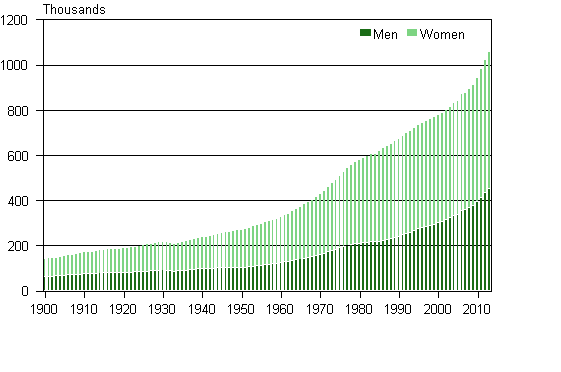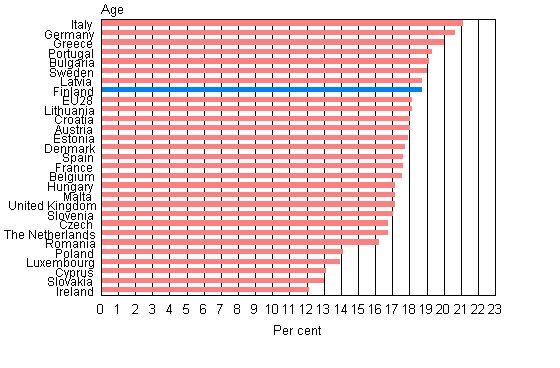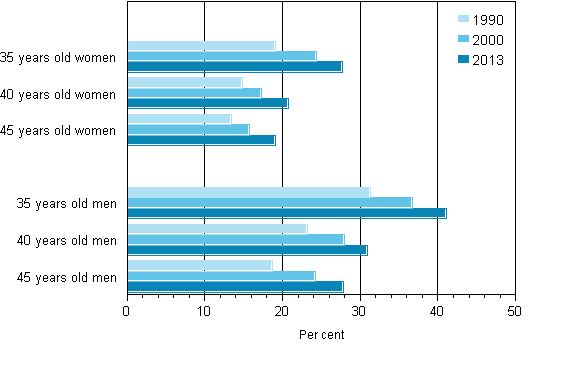Published: 26 September 2014
Nearly every fifth Finn is aged 65 or over
Correction. The published figures corrected on the 26th of September, 2014. The corrected figures are indicated in red.
According to Statistics Finland's statistics on population structure, there were 1,056,547 persons aged 65 or over in Finland's population at the end of 2013. Their proportion of the total population was 19.4 per cent. The number of persons aged 65 or over has doubled since the mid-1970s and quadrupled since the war years.
Number of persons aged 65 or over in Finland's population in 1900 to 2013

In relative terms, Finland has the eight most persons aged 65 or over among EU 28 countries
According to Eurostat's 2012 statistics, Italy has relatively the largest proportion of persons aged 65 or over of its population, 21.2 per cent. The second largest proportion of the population was in Germany, 20.7 per cent and the third largest in Greece, 20.1 per cent. At the end of 2012, Finland's share among EU 28 countries was the eight highest, i.e. 18.8 per cent. The share of persons aged 65 or over of the population was lowest in Ireland, 12.2 per cent.
Share of persons aged 65 or over of the population in EU 28 countries in 2012, per cent

One in four is 65 or over in the population of Etelä-Savo
Viewed by region, the share of persons aged 65 or over of the population was largest in the region of Etelä-Savo, 26.0 per cent. In Kymenlaakso, South Karelia and Kainuu, the share of persons aged 65 or over was 23.6 per cent. Correspondingly, in the regions of Uusimaa (15.7 per cent) and North Ostrobothnia (16.2) the share of persons aged 65 or over was lowest.
Viewed by municipality, the share of persons aged 65 or over was highest in Luhanka (40.1 per cent), Kuhmoinen (39.0) and Sottunga (35.0). Correspondingly, the share was lowest in the municipalities of Liminka (8.4 per cent), Tyrnävä (11.1) and Pornainen (12.1).
Population’s average age highest in Sottunga, lowest in Liminka
The average age of the entire population stood at 41,9 years at the end of 2013. The average age of men was 40,5 years and that of women 43,3 years. Of the regions, the average age was highest in Etelä-Savo, 46,7 years and lowest in North Ostrobothnia, 38,8 years. Of the municipalities, the average age was highest in Sottunga, 56,3 years, and lowest in Liminka, 30,6 years.
Every fifth woman aged 45 and every fourth man aged 45 have no children
The share of childless women and men has continued growing. In all, 19.1 per cent of women aged 45 and 27.9 per cent of men of the same age were childless at the end of 2013. In 1990, the respective shares were 13.4 per cent for women and 18.7 per cent for men.
Share of childless persons by age and sex in 1990, 2000 and 2013

The effect of postponing having children is also visible in younger age groups. In 1990, the share of childless women aged 35 was 19.2 per cent of the age group, while at the end of 2013 the share was 27.7 per cent. Among men aged 35, the share of childless men has increased from 31.4 per cent at the end of 1990 to 41.1 per cent.
Number of childless women highest in Uusimaa, lowest in Ostrobothnia
In Ostrobothnia, the share of those without children among 45-year-old women was 13.3 per cent at the end of 2013. In the region of Uusimaa, almost one-in-four women aged 45 (23.3 per cent) were childless and of 45-year-old women living in Helsinki 31.5 per cent did not have any children. The regional differences for men are almost as large. Of 45-year-old men living in Central Ostrobothnia, 22.8 per cent were childless. Among 45-year-old men living in Etelä-Savo 30.7 per cent and among men of the same age living in Helsinki 38.6 per cent did not have any children.
Among women aged 45 who speak Swedish as their native language the share of childless women was 16.4 per cent and among those who speak Finnish as their native language the corresponding share was 18.6 per cent. Also, among men aged 45 with Swedish as their native language the share of childless men (23.9 per cent) was lower than among those having Finnish as their native language (27.4 per cent).
Share of childless persons highest among unmarried persons and persons with low level of education
For one-quarter of all 45-year-old women the marital status was unmarried, while 56 per cent were married, 17 per cent divorced and one per cent were widowed. Among childless women aged 45 two in three were unmarried, around one-quarter were married, nine per cent were divorced and fewer than one per cent were widowed.
Among women aged 45 with a national language (Finnish, Swedish, Sami) as their native language and with at most basic level education, 22.3 per cent were childless. Correspondingly, the share of childless women among those with both upper secondary level qualifications and tertiary level qualifications was 18.1 per cent. For men aged 45 with a national language as their native language the share of childless men among those with at most basic level education was 33.7 per cent, 29.0 per cent among those with upper secondary level qualifications, and 22.0 per cent among those with tertiary level qualifications (data on education are based on the situation at the end of 2012).
Five-sixths of the Finnish population live in an area covering 2.2 per cent of Finland’s total land area
The majority of the Finnish population is concentrated around urban settlements. According to the locality boundaries produced in cooperation between Statistics Finland and the Finnish Environment Institute, nearly 85 per cent of Finns, or 4,574,758 persons, lived in urban settlements at the end of 2013. An urban settlement is not dependent on municipal borders, as it can stretch over the area of several municipalities. There were 750 urban settlements with a total land area of 6,637.5 km2 at the end of 2013. Approximately five out of six Finns lived in an area that covers only 2.2 per cent of the total land area of Finland.
The majority of the urban settlements are small. More than one-half of the urban settlements have 200 to 999 inhabitants. According to the 2013 locality boundaries, only 4.4 per cent of the urban settlements were large with at least 20,000 inhabitants. Measured by population, the largest urban settlement is the Helsinki central locality with nearly 1.2 million inhabitants. The Helsinki central locality is also the largest urban settlement measured by area, as it stretches over the area of as many as 11 municipalities . Its land area is 641.9 km2. According to the situation at the end of 2013, there were six urban settlements with more than 100,000 inhabitants in Finland: the Helsinki, Tampere, Turku, Oulu, Jyväskylä and Lahti central localities.
Source: Population Structure 2013, Statistics Finland
Inquiries: Markus Rapo 029 551 3238, vaesto.tilasto@stat.fi
Director in charge: Riitta Harala
Publication in pdf-format (444.4 kB)
- Tables
-
Tables in databases
Pick the data you need into tables, view the data as graphs, or download the data for your use.
Appendix tables
- Appendix table 1. Sizes of municipalities by region 31.12.2013 (26.9.2014)
- Appendix table 2. Married women by duration and order of marriage 31.12.2013 (26.9.2014)
- Appendix table 3. Females aged 15 - 78 by number of live-born children 31.12.2013 (26.9.2014)
- Appendix table 4. Males aged 15 - 78 by number of live-born children 31.12.2013 (26.9.2014)
- Appendix table 5. Women by age, number of children and the proportion of birth 31.12.2013 (26.9.2014)
- Appendix table 6. Males by age and number of children 31.12.2013 (26.9.2014)
- Figures
-
- Appendix figure 1. Swedish-speakers' proportion of the population in 1900 - 2013 (26.9.2014)
- Appendix figure 2. Demographic dependency ratio in 1950 - 2013 and projection for 2014 - 2050 (26.9.2014)
- Appendix figure 3. Share of persons not belonging to religious communities by gender 1990 - 2013 (26.9.2014)
- Appendix figure 4. Finlands statistical localities 2013 (26.9.2014)
- Quality descriptions
-
- Quality description: Population structure 2013 (26.9.2014)
Updated 26.9.2014
Official Statistics of Finland (OSF):
Population structure [e-publication].
ISSN=1797-5395. annual review 2013. Helsinki: Statistics Finland [referred: 30.11.2025].
Access method: http://stat.fi/til/vaerak/2013/01/vaerak_2013_01_2014-09-26_tie_001_en.html

